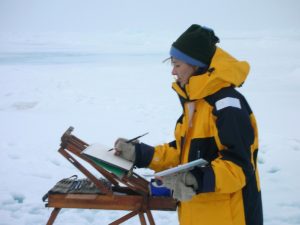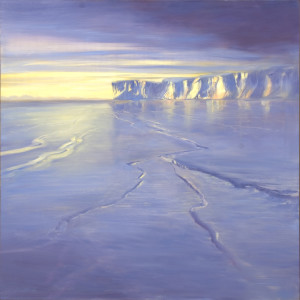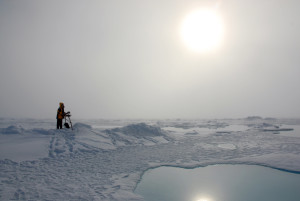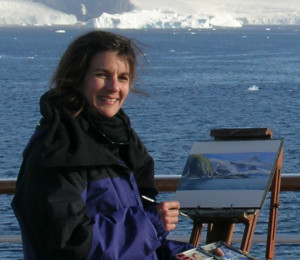I delight in being alone in nature, and gazing over an expanse of untouched wilderness. Feeling this deep connection with the earth especially in the polar regions, I strive to express it in painting.
Now, more than ever, the polar regions show obvious signs of how we have affected their ecosystems. Painting can elicit a deep sense of connection to nature, and through this connection, I believe it can foster stewardship of the environment. Through painting, I hope to inspire this emotional connection in viewers who may not have the opportunity to experience the polar regions themselves.

In 1985, I had the good fortune to travel to Antarctica under the auspices of the National Science Foundation (NSF) to illustrate a book about the natural history of the Antarctic Peninsula. This led to two more NSF artist residencies in Antarctica, to illustrate several more science books, as well as do my own paintings. My most memorable field experience took place in 1995, when I lived for two and half months in a fish hut on Antarctica’s frozen Ross Sea. When I first arrived at the end of the Austral winter, the landscape was more or less barren. The dry air dipped into the minus 50s Fahrenheit. All bundled up, I would walk across the sea ice, and imagine the endless winter night. Now the sun would rise, crawl along the horizon for three hours, then sink again. The darkening the sky would soon glisten with stars that shed an eerie light on the endless expanse of ice. Pure stillness reigned, with the dead silence broken only by ghostly pings of cracking sea ice. As the season progressed into Austral spring, more cracks appeared and widened, a sign of the seasonal melting of the ice. In a couple of months, the ice beneath my feet would be open ocean. I am struck by how dramatically the ice changes with a rise of temperature and I try to express that in my paintings.

Thus I strive to capture not only the land and ice forms but the sense of the place itself: the way the sunlight highlights a contour of ice, the way ice reflects sky, and sky reflects ice, the long shadows of low sunlight, and the warm hues of gold, rose, and peach. Unlike the fleeting twilight in temperate regions, the twilight in polar regions with its long shadows, can last most of the night.
In the open ocean, silhouettes of sculpted icebergs drift across the far horizon. Their serene reflections disappear in minutes when the sky darkens, and the wind whips up dark waves so fierce that all life hunkers down except for the albatrosses. The albatross takes flight from the ocean surface to ride the air currents with ease when the wind rises. To every extreme niche, there’s a creature that thrives; one that may appear tough, but in another sense is fragile, as it is dependent on an unchanging environment to which it has long been adapted.

I travelled to the Arctic aboard icebreakers. Beginning in 2006, on one of my trips, I gazed over the expanse of frozen Arctic Ocean north of Russia and spotted a lone polar bear lumbering across the distant ice. I was in awe of its ability to thrive in such a hostile place even in mid-summer. In awe of its lifestyle … to be able to roam an endless frozen ocean with stamina and purpose even though there is no dark of night to mark time, and seemingly no landmarks by which to navigate. This mammal that so resembles us in its warm bloodedness and facial expressions, yet so different in temperament, sniffs the Arctic air contemplatively and walks with resilience and confidence. How tough this creature seems, and yet how vulnerable it is, dependent on the sea ice that is diminishing more and more each year.

In the Arctic, the intricate lace of sea ice reveals patterns of turquoise melt pools unlike anything I saw in Antarctica. In Antarctica, a more dramatic feel pervades the ice, both on the sea ice and in glaciers cascading from towering mountains. Whether it’s the Arctic or Antarctica, I reach for my paints. I believe painting can provoke new thoughts about polar landscapes. I hope my paintings, in reflecting my passion for the places I’ve described here and their animal inhabitants will inspire others to help protect our planet.
The artworks by Lucia deLeiris published in this post are currently on national tour in the traveling museum exhibition, Environmental Impact.
 Lucia deLeiris currently lives in Massachusetts. With a degree in zoology from the University of Maryland, deLeiris came to her career in art through a research assistant at the Smithsonian National Zoo Conservation and Research Center, where she stayed on to illustrate a book and an animated introduction for the Zoo’s documentary, The Last Chance. Her interests in science and the workings of the natural world regularly find their way into her sketches and paintings.
Lucia deLeiris currently lives in Massachusetts. With a degree in zoology from the University of Maryland, deLeiris came to her career in art through a research assistant at the Smithsonian National Zoo Conservation and Research Center, where she stayed on to illustrate a book and an animated introduction for the Zoo’s documentary, The Last Chance. Her interests in science and the workings of the natural world regularly find their way into her sketches and paintings.
This post is part of the newly launched MAHB’s Arts Community space –an open space for MAHB members to share, discuss, and connect with artistic processes and products pushing for change. Please visit the MAHB Arts Community to share and reflect on how art can promote critical changes in behavior and systems. Please contact Erika with any questions or suggestions you have regarding the new space.
MAHB-UTS Blogs are a joint venture between the University of Technology Sydney and the Millennium Alliance for Humanity and the Biosphere. Questions should be directed to joan@mahbonline.org
MAHB Blog: https://mahb.stanford.edu/blog/provoking-new-thoughts
The views and opinions expressed through the MAHB Website are those of the contributing authors and do not necessarily reflect an official position of the MAHB. The MAHB aims to share a range of perspectives and welcomes the discussions that they prompt.
